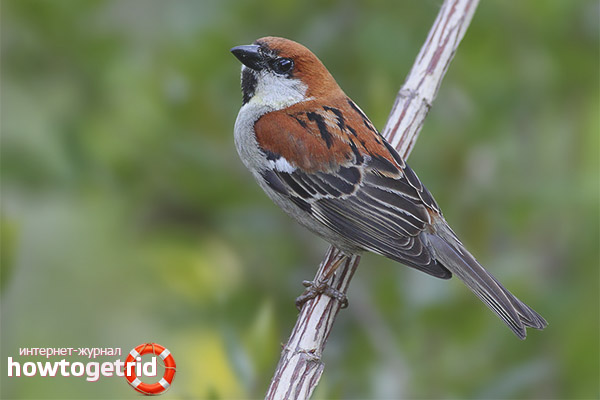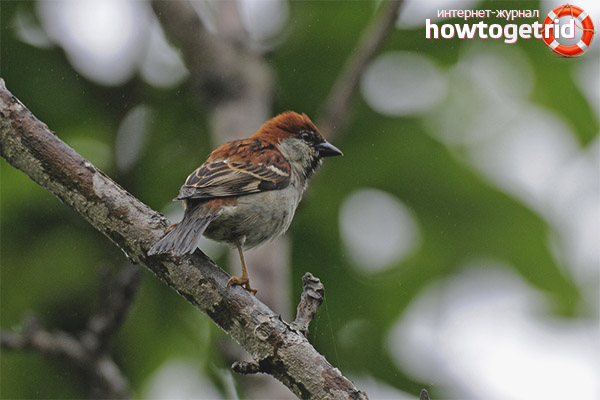The content of the article
All residents of the city are accustomed to an abundance of sparrows on city streets, in parks, squares. They sit in trees, talking among themselves, or roam the earth in search of a worm or something to eat. You can meet this nimble bird underfoot at the bus stop, where they wait until they throw bread and seeds, a lot of them whisk and crowd in anticipation near the cafe. And if the sparrow does not even catch the eye, then peppy chirps are always heard.
The townsman is ready to call any small gray pichuga a sparrow. Not knowing that as many as two species inhabit them in the city - field and house. And a couple of species live in the Caucasus - Spanish and stone. And in the Central Asian territories lives Indian. And in general - in the family of 8 passerine genera of birds with almost 40 species. There are representatives in this form, which are rarely seen near a person - this is a red sparrow.
Description
In appearance and other parameters, it bears a very great resemblance to the usual urban field sparrow: it is also small, nimble and stocky. He only has one difference - he wears a bright red cap on his head. The redhead is not only the head, but also the back with a muzzle - they are also gray-brown with scattered black streaks. For this outfit, a sparrow got its name.
Another nuance - unlike city dwellers, where all the sparrows are on one face, it is quite easy to distinguish a female from a male in red sparrows. Females are unprepossessing, devoid of bright colors, the appearance seems simple and faded. And the males are bright and elegant: the head on the sides is white, the chest and stomach are gray-white, the wings with a brown tail. The throat is black, a strip of the same color, extending from the eye to the beak and looking like an eyebrow.
The female is dressed paler and not so colorful. Her plumage is devoid of black and red shades. The upper body is brown, the bottom is the same as that of a male - light gray. Above the eye there is a light gray-yellow strip similar to an eyebrow.
Habitat
The red sparrow inhabits for the most part in the south and southeast of Asia, the habitat extends from the southern part of the Sakhalin peninsula and the Kuril Islands in Russian territory to southern China and the north-western regions of India, including the Himalayas, Korea, Japan, Laos. Prefers to live in broad-leaved forests (oak, maple, elm) away from human settlements.
In warm areas (China, the Himalayas) they live in colonies, arranging nests next to each other (35-55m), but in Russia they prefer a solitary lifestyle and live in pairs.
Breeding and nesting
At first males arrive, and after 7-10 days females appear. Nests are most often equipped in old abandoned hollows; they can also settle in birdhouses, on the eaves of stone walls or in their crevices. On the Kuril Islands and Sakhalin, sometimes they build a nest in the bushes. They build housing from the stems and roots of various herbs, use lichens as a building material. The bottom is lined with feathers and hair. Both male and female are involved in the construction process.
The female makes a clutch consisting of 5-6 eggs. The color is whitish or bluish, near the blunt end dotted with brownish dots and spots. The periods of incubation as in an ordinary field sparrow are from one and a half to two weeks. Both parents also hatch. Hatching three to five grams chicks feed both parents 10-14 days. Then the chicks fly away from the nest, forming small flocks.
Behavior and Nutrition
Red sparrows spend most of their lives in trees, settling on a branch, descend to the ground only for food. The diet consists mainly of plant foods - seeds, berries, weeds, grains and cereals. Only at the time of breeding lean on animal feed - caterpillars, worms, beetle larvae. They also feed offspring.
Wintering
Interesting Facts
Common sparrows make several clutches per season, while the red sparrow lays eggs a maximum of two times. In the northern regions - only once.
The life span of a red sparrow is about three years.
The red sparrow found reflection in Japanese art - the images of these birds dressed in a red cap adorn national postage stamps.











Submit